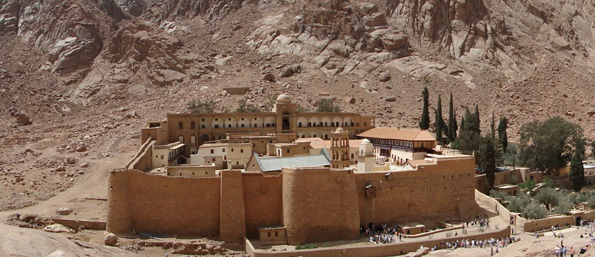Saint Catherine's Monastery—officially "Sacred and Imperial Monastery of the God-Trodden Mount of Sinai"—located in the Sinai Peninsula, is one of the oldest functioning Christian monasteries. Constructed in the sixth century under the orders of Justinian I (r. 527–565), it was built in the spot where, according to Christian belief, the angels brought the body of Saint Catherine of Alexandria after her execution. It also enclosed the existing chapel built by Helena, mother of Constantine I, to commemorate the site where Moses observed the burning bush. The site was originally dedicated to the Virgin Mary but was eventually rededicated to Saint Catherine.
Many rare documents, icons, and liturgical objects have survived for centuries within the monastery's walls, under the protection of the monks who consider it their duty to preserve them. One of the most important and imposing works of art in the monastery is the sixth-century mosaic depicting the Transfiguration that decorates the sanctuary apse in the main church (Katholikon).
In the Byzantine world, Saint Catherine's Monastery was considered one of the most important Christian pilgrimage sites. Established routes leading to the site existed as early as the fourth century, but construction ordered by Justinian in the sixth century enhanced the destination by converting it into a magnificent basilica with surrounding walls. The community of monks living at Sinai remained protected within this fortress, surviving several wars and other troubles while also remaining open to pilgrims visiting from around the world. Several religions consider Sinai to be sacred and worship there in a harmonious environment.
